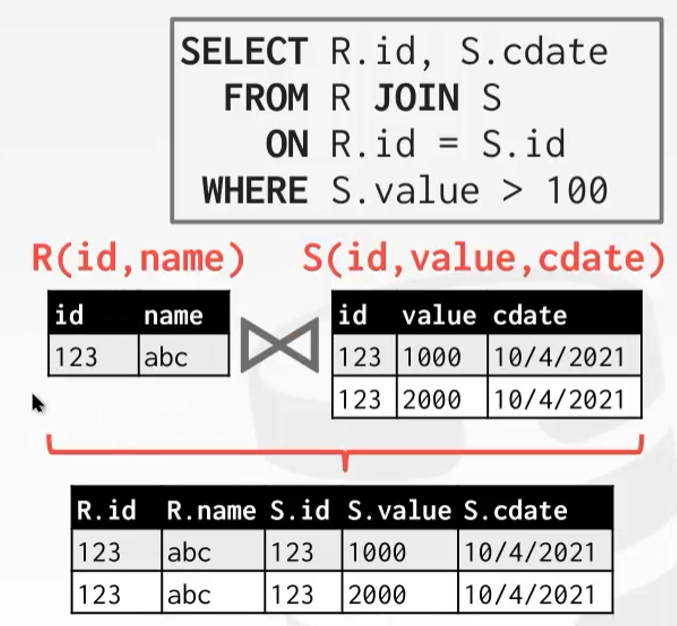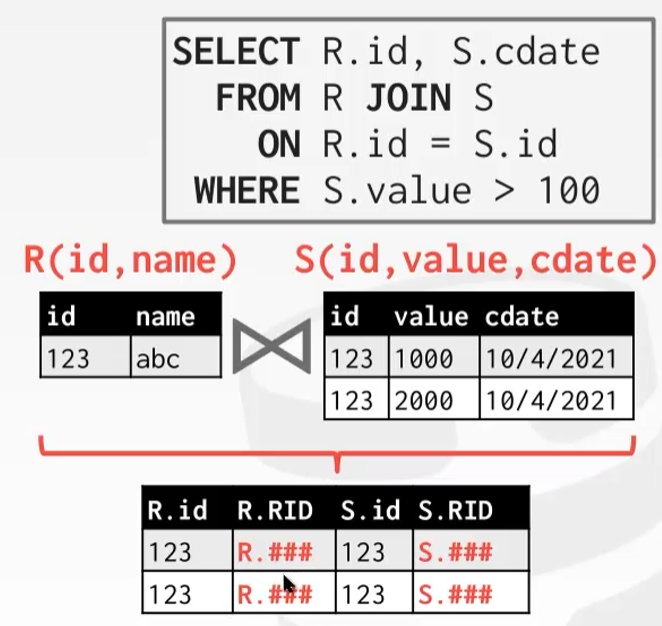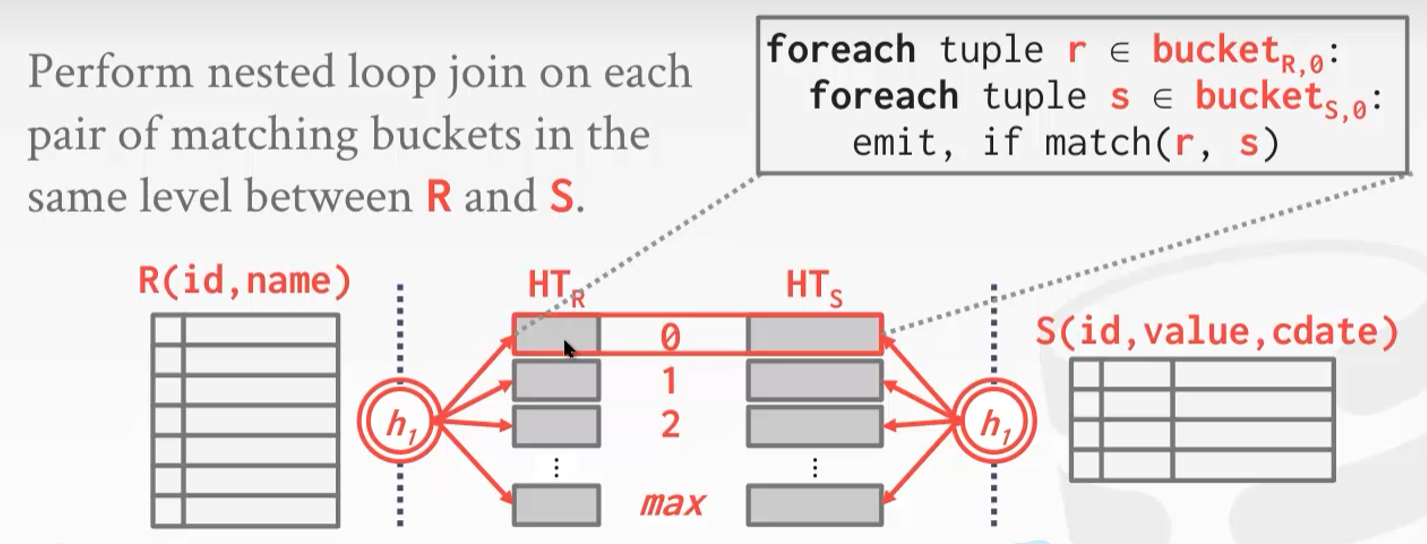CMU 15-445 Lecture #11: Joins Algorithms
CMU 15-445 Database Systems
Lecture #11: Joins Algorithms
Introduction
-
根据数据库的范式理论,设计数据库表的一个原则是不让数据冗余,所以在查找的时候JOIN的操作是少不了的
-
For binary joins, we often prefer the left table (the ”outer table” ) to be the smaller one of the two.优化SQL的一个方法,左表尽量小(这个小指的是文件页数少),后面会说明原因
Join Operators
- Operator Output
-
Cost Analysis
-
不同JOIN算法的开销
-
Assume
-
M pages in table R, m tuples in R
-
N pages in table S, n tuples in S
-
1 2 3 4SELECT R.id, S.cdate FROM R JOIN S ON R.id = S.id WHERE S.value > 100;
-
-
Cost Metric: number of IOs to compute join
-
JOIN Algorithms
- Next Loop Join
- Sort-Merge Join
- Hash Join
-
Nested Loop Join
- Native Nested Loop Join
- 伪代码
|
|
-
“stupid nested loop join”
- 一个R中的tuple需要扫S表的所有数据,对于缓存池的利用率过低,这种方法开销太大
- S每次都是先灌满缓存池,然后前面的页淘汰,如此反复
-
Assume
-
M pages in table R, m tuples in R
-
N pages in table S, n tuples in S
-
-
Cost: $M+(m \times N)$
-
优化:高效利用缓存池,一次多加载一些页,不要一页一页加载
-
Block Nested Loop Join
-
伪代码
|
|
-
每次不只读一页,每次R和S都读好多页进行匹配
-
Cost: $M+(\frac{M}{M\ Block\ Size} \times N)$
-
讨论block size
-
B个页的内存,一个页做输出缓存,一个页给右表,多缓存左表(给B-2个)
|
|
-
Cost: $M+(\frac{M}{B-2}\times N)$
-
if $B-2>M$, then cost: $M+N$
-
为啥nested loop join性能不行
- 总要去遍历S表
- 为啥要遍历:没有索引等其他方案来提高查找S中属性的效率,所以只能傻瓜式的遍历
-
优化思路:提高S中查找/范围查找的速度
-
Index Nested Loop Join
|
|
-
认为每次索引查询需要C次I/O
-
Cost: $M+(m\times C)$
Sort-Merge Join
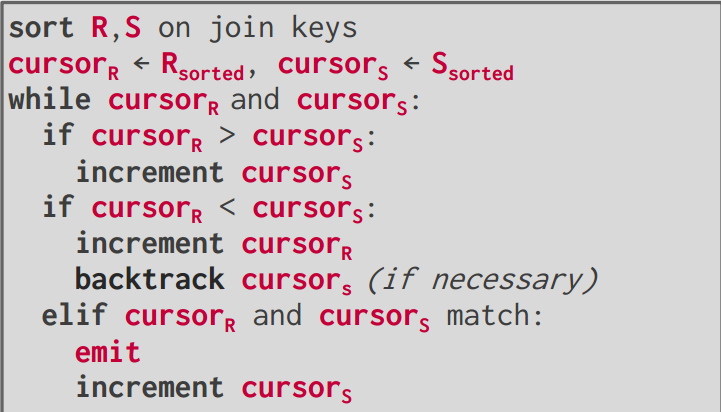
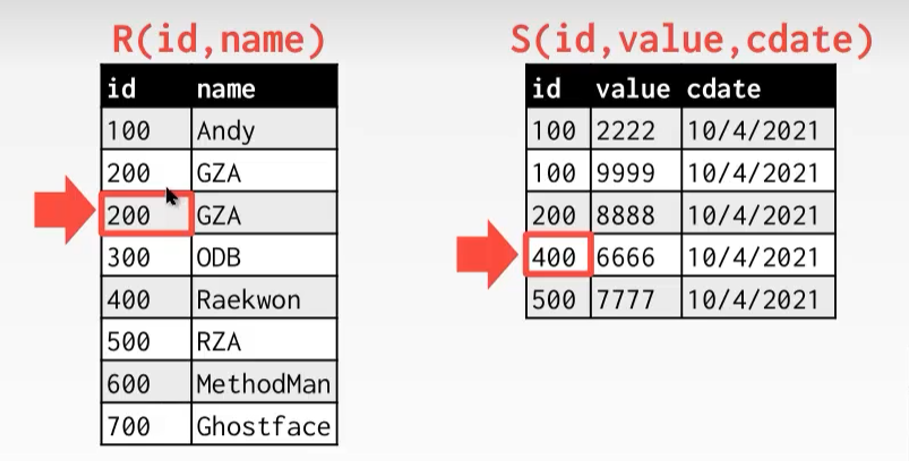
-
Cost
-
Sort R: $2M \times (1+\log_{B-1}\frac{M}{B})$
-
Sort S: $2N\times (1+\log_{B-1}\frac{N}{B})$
-
Merge Cost: $M+N$
-
Total Cost: $Sort + Merge$
-
-
退化情况:两个连接列所有值一样,那么Merge Cost会因为回退增加到$M\times N$
-
适合的场景
- 数据本身就有序
- 输出的结果需要排序
Hash Join
- Hash table点查询比B+ Tree快
- 左表做hash,右表去匹配
|
|
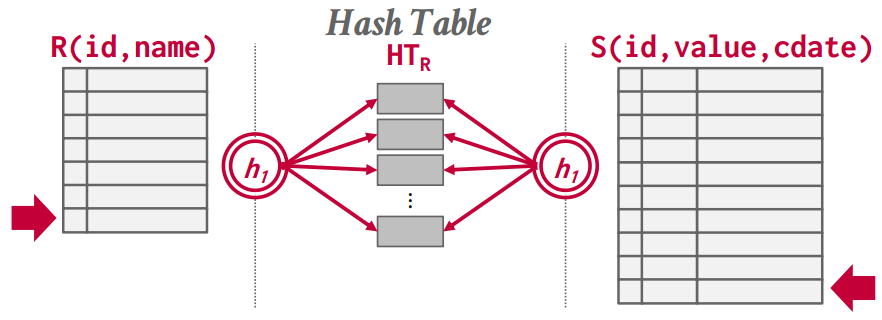
-
Hash
- Key:需要连接的列
- Value
- Full Tuple:放上需要的数据,不需要回表
- Tuple Identifier:放索引,最后需要去回表拿数据
-
OPTIMIZATION
- Create a probe filter (such as a Bloom Filter) during the build phase if the key is likely to not exist in the inner relation 加上一层过滤器先过滤掉部分没有匹配项的数据,防止在哈希表里面找半天发现没有,比如加一个布隆过滤器
-
如果哈希表太大可能会面临内存池驱逐的问题,但是我们不想让内存池随机驱逐
-
Grace Hash Join
-
Cost
- Partition Phash:$2(M+N)$(读到内存hash后还要写回去)
- Probing Phash:$M+N$
- Total:$3(M+N)$
Conclusion

- Sorting和Hash没有最好,要看条件选择
- 哈希碰撞,输出是否有序都会影响开销
- 优秀的数据库会有优化器来进行分析和选择
